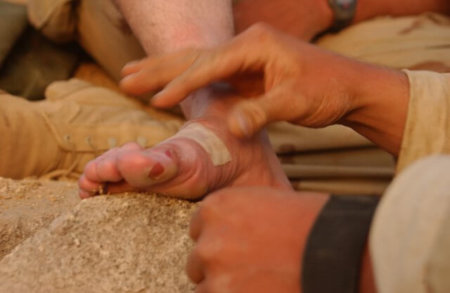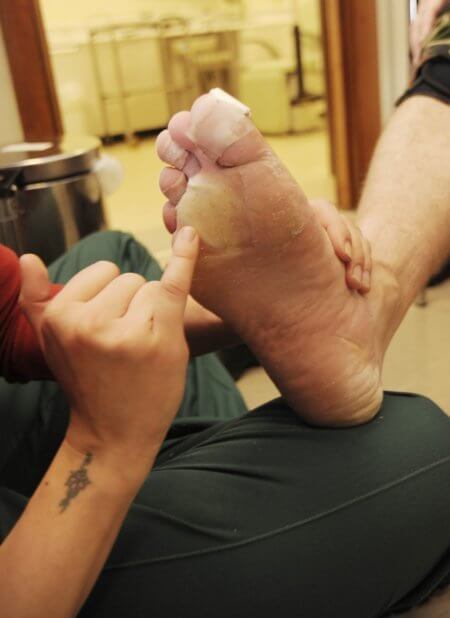Getting hiking blisters is very common, but how you deal with them can make or break the rest of your trip. While many people think that blisters are simply an annoyance that can be ignored until you get back to the car or your home, they actually require immediate treatment.
Knowing how to treat blisters and taking care of them right away is important, no matter if you are on a short hike with the family or heading out into the woods for days on end.
Treating a Blister When it’s a Hot Spot
Hikers who pay a lot of attention to their feet may be lucky enough to realize that they are going to develop a blister and then take care of it before it gets too bad. If you have a hot spot on your foot, then you need to stop and treat it right away before it gets any worse.
Immediately find a safe place to sit and remove your sock and shoe so that you can see the hot spot. If you are lucky enough to find the hot spot before it turns into a full-blown blister, then you can easily treat it with duct tape.
How far can you really walk in a day? You’d be surprised!
Wrapping the area of your foot with a few layers of duct tape will reduce friction between your boot and foot.
I always add a bandage if I have one available. Putting tape directly on the skin can sometimes cause more issues than it prevents.
It’s a good idea to add an antibiotic ointment before wrapping the hot spot if the skin is raw and red. Never tape over your toes unless they are also rubbing against your boots.

Treating Small Blisters on the Trail
Once a hot spot has turned into a blister it will require slightly different care for you to avoid more problems. Small hiking blisters can easily be treated with a pad and some gel. The pad is there to provide cushioning and to reduce the pressure of the boot on the painful area of your foot.
Any gels and antibiotic ointments can be added under a bandage to help cool off the area and prevent infection.
If a blister is small enough, then it can be treated with duct tape or moleskin in the same way as a hot spot. This ensures that the skin isn’t exposed to a lot of friction, which can cause more irritation. Slightly larger blisters, however, may need the treatment and additional care of a padded dressing.
Using a piece of molefoam, cut a hole out of the center that is large enough for the blister. Carefully place the doughnut on the blister and hold it in place while putting your sock back on. If the doughnut slips when you walk, then you will want to use a piece of tape over the top to ensure that it stays in place. This keeps pressure off of your blister.

Dealing with Larger Blisters
Large blisters require more care and may even need to be drained, depending on how large they are and if there is a chance of them bursting in your boot. When a blister has become so large that you are having difficulty walking, then you need to prepare yourself to pop it and then wrap it up.
Prepare your foot by carefully washing the blister, as well as the area around it, with an antibiotic soap to try to create a sterile environment. Using alcohol or the flame in a fire, sterilize your needle. This ensures that you are not transferring bacteria to the inside of your blister when you pop it.
Turn your foot so that you can see the base of the blister, as you are going to want to insert the needle as close to the base of the blister as possible. Carefully insert the needle and then remove it, allowing the fluid inside of the blister to drain out.
Once the blister has been completely drained, you will need to dress it.
First, use antibiotic ointment on the wound and then wrap it with a bandage or gauze. Create a doughnut and place it on the blister to reduce the chance of a sock or boot causing further irritation.
It is very rare for a blister to become infected, especially when you are careful when draining them, but you do need to keep an eye on your blisters. If there are red streaks from the blister, pus, or you develop a lot of pain around the blister, then you will want to seek immediate medical care.
While you can’t always prevent hiking blisters from occurring when you’re hiking, knowing what to do when you have them is important. It’s always a good idea to pack the items that you need for dealing with blisters, no matter how long you are going to be on the trail.
This ensures that you are always prepared to deal with any problems that may arise and that you can treat and care for your blisters quickly so that they don’t continue to get worse or cause additional problems.

